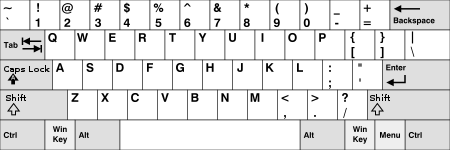| Revision as of 14:28, 18 October 2008 editDragonBot (talk | contribs)56,554 editsm robot Adding: pl:Delete (klawisz)← Previous edit | Revision as of 19:35, 16 December 2008 edit undoTechBot (talk | contribs)12,222 editsm robot Modifying: de:Entfernen (Taste)Next edit → | ||
| Line 25: | Line 25: | ||
| ] | ] | ||
| ] | ] | ||
| ] | ] | ||
| ] | ] | ||
| ] | ] | ||
Revision as of 19:35, 16 December 2008

The delete key, known less ambiguously as forward delete, Del, or ⌦, performs a function when struck on a computer keyboard during text or command editing which discards the character ahead of the cursor's position, moving all following characters one position "back" towards the freed place. The key appears on IBM-compatible PC keyboards labeled as Delete, or Del. On Mac keyboards, the key which performs this function is labeled del and ⌦, as the full word delete is reserved for labelling the key otherwise known as Backspace.
The delete key may generate the ASCII delete character, 7F hex (127 decimal), which reflects its history in 7-bit paper tape. If a character was punched erroneously, punching out all seven bits caused it to be ignored (or deleted). Unix retained the Delete key as the way to erase characters, while DOS/Windows used the backspace (0x08, or control-H) instead. The delete key may also be mapped to ESC [3 ~ which is the VT220 escape code for the "delete character" key.
On many notebook computer keyboards the key labeled Delete (sometimes Delete and Backspace are printed on the same key) serves the same purpose as a Backspace key. Othertimes, the Delete Key is in its original IBM notebook position of above and to the right of the Backspace key. Many laptops, to add keys on a non-standard size keyboard add rows of smaller keys above the Function Key line. On this line, the Delete Key is often the third key in from the right. On Apple Inc.'s line of laptops (notably the MacBook and MacBook Pro), the function of the delete key can be achieved by pressing the Fn key and the delete/backspace key.
Sometimes this desired effect is replaced by inserting "^H" (or, less frequently, "^?") instead. This is related to ASCII control characters for BS and DEL.
Also, the delete key often works as a generic command to remove an object (such as an image embedded in a document, or a file in a file manager).
The delete key, on many modern motherboards also functions to open the BIOS screen, when pressed after starting the computer.
References
- "9.8 Keyboard configuration". Debian Policy Manual.
See also
| IBM PC keyboard (Windows, ANSI US layout) | ||||||||||||||||||||||||
|---|---|---|---|---|---|---|---|---|---|---|---|---|---|---|---|---|---|---|---|---|---|---|---|---|
| Esc | F1 | F2 | F3 | F4 | F5 | F6 | F7 | F8 | F9 | F10 | F11 | F12 | PrtScn/ SysRq |
Scroll Lock |
Pause/ Break |
|||||||||
 |
Insert | Home | PgUp | Num Lock |
∕ | ∗ | − | |||||||||||||||||
| Delete | End | PgDn | 7 | 8 | 9 | + | ||||||||||||||||||
| 4 | 5 | 6 | ||||||||||||||||||||||
| ↑ | 1 | 2 | 3 | Enter | ||||||||||||||||||||
| ← | ↓ | → | 0 Ins |
. Del | ||||||||||||||||||||
| Keyboard keys | |
|---|---|
| Dead keys | |
| Modifier keys | |
| Lock keys | |
| Navigation keys | |
| Editing | |
| Contextual | |
| Misc. | |